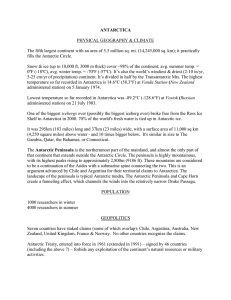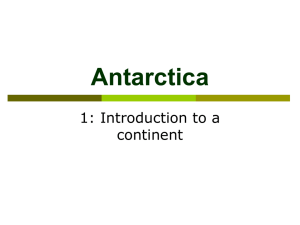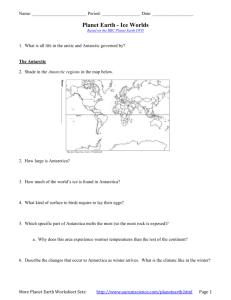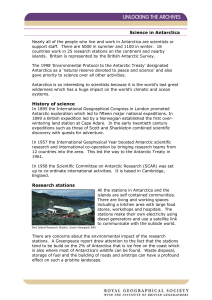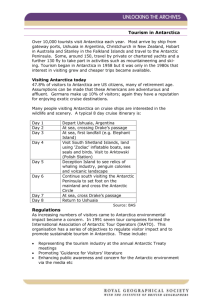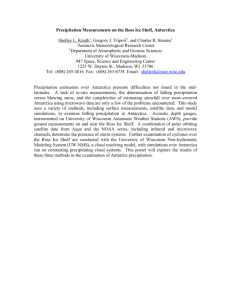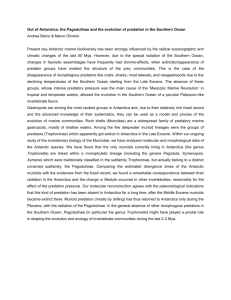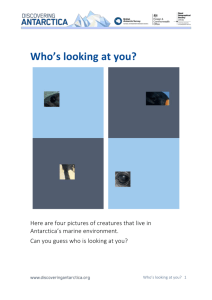Implementing an Environmental Management Regime in Antarctica Paul R. Dingwall
advertisement
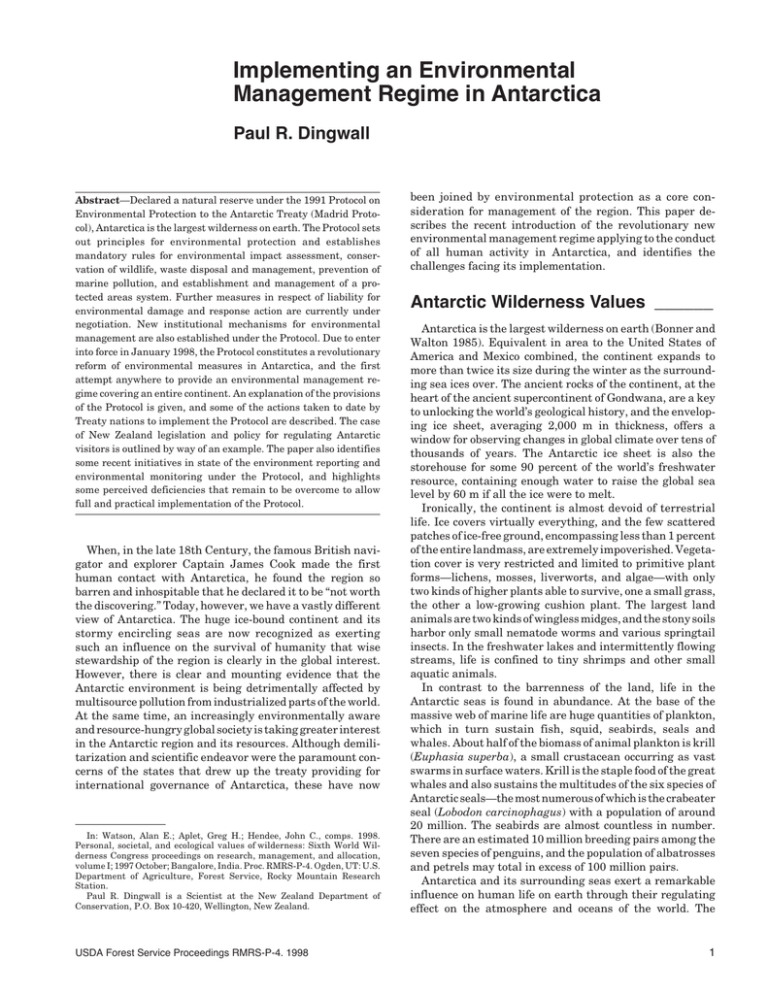
Implementing an Environmental Management Regime in Antarctica Paul R. Dingwall Abstract—Declared a natural reserve under the 1991 Protocol on Environmental Protection to the Antarctic Treaty (Madrid Protocol), Antarctica is the largest wilderness on earth. The Protocol sets out principles for environmental protection and establishes mandatory rules for environmental impact assessment, conservation of wildlife, waste disposal and management, prevention of marine pollution, and establishment and management of a protected areas system. Further measures in respect of liability for environmental damage and response action are currently under negotiation. New institutional mechanisms for environmental management are also established under the Protocol. Due to enter into force in January 1998, the Protocol constitutes a revolutionary reform of environmental measures in Antarctica, and the first attempt anywhere to provide an environmental management regime covering an entire continent. An explanation of the provisions of the Protocol is given, and some of the actions taken to date by Treaty nations to implement the Protocol are described. The case of New Zealand legislation and policy for regulating Antarctic visitors is outlined by way of an example. The paper also identifies some recent initiatives in state of the environment reporting and environmental monitoring under the Protocol, and highlights some perceived deficiencies that remain to be overcome to allow full and practical implementation of the Protocol. When, in the late 18th Century, the famous British navigator and explorer Captain James Cook made the first human contact with Antarctica, he found the region so barren and inhospitable that he declared it to be “not worth the discovering.” Today, however, we have a vastly different view of Antarctica. The huge ice-bound continent and its stormy encircling seas are now recognized as exerting such an influence on the survival of humanity that wise stewardship of the region is clearly in the global interest. However, there is clear and mounting evidence that the Antarctic environment is being detrimentally affected by multisource pollution from industrialized parts of the world. At the same time, an increasingly environmentally aware and resource-hungry global society is taking greater interest in the Antarctic region and its resources. Although demilitarization and scientific endeavor were the paramount concerns of the states that drew up the treaty providing for international governance of Antarctica, these have now In: Watson, Alan E.; Aplet, Greg H.; Hendee, John C., comps. 1998. Personal, societal, and ecological values of wilderness: Sixth World Wilderness Congress proceedings on research, management, and allocation, volume I; 1997 October; Bangalore, India. Proc. RMRS-P-4. Ogden, UT: U.S. Department of Agriculture, Forest Service, Rocky Mountain Research Station. Paul R. Dingwall is a Scientist at the New Zealand Department of Conservation, P.O. Box 10-420, Wellington, New Zealand. USDA Forest Service Proceedings RMRS-P-4. 1998 been joined by environmental protection as a core consideration for management of the region. This paper describes the recent introduction of the revolutionary new environmental management regime applying to the conduct of all human activity in Antarctica, and identifies the challenges facing its implementation. Antarctic Wilderness Values ______ Antarctica is the largest wilderness on earth (Bonner and Walton 1985). Equivalent in area to the United States of America and Mexico combined, the continent expands to more than twice its size during the winter as the surrounding sea ices over. The ancient rocks of the continent, at the heart of the ancient supercontinent of Gondwana, are a key to unlocking the world’s geological history, and the enveloping ice sheet, averaging 2,000 m in thickness, offers a window for observing changes in global climate over tens of thousands of years. The Antarctic ice sheet is also the storehouse for some 90 percent of the world’s freshwater resource, containing enough water to raise the global sea level by 60 m if all the ice were to melt. Ironically, the continent is almost devoid of terrestrial life. Ice covers virtually everything, and the few scattered patches of ice-free ground, encompassing less than 1 percent of the entire landmass, are extremely impoverished. Vegetation cover is very restricted and limited to primitive plant forms—lichens, mosses, liverworts, and algae—with only two kinds of higher plants able to survive, one a small grass, the other a low-growing cushion plant. The largest land animals are two kinds of wingless midges, and the stony soils harbor only small nematode worms and various springtail insects. In the freshwater lakes and intermittently flowing streams, life is confined to tiny shrimps and other small aquatic animals. In contrast to the barrenness of the land, life in the Antarctic seas is found in abundance. At the base of the massive web of marine life are huge quantities of plankton, which in turn sustain fish, squid, seabirds, seals and whales. About half of the biomass of animal plankton is krill (Euphasia superba), a small crustacean occurring as vast swarms in surface waters. Krill is the staple food of the great whales and also sustains the multitudes of the six species of Antarctic seals—the most numerous of which is the crabeater seal (Lobodon carcinophagus) with a population of around 20 million. The seabirds are almost countless in number. There are an estimated 10 million breeding pairs among the seven species of penguins, and the population of albatrosses and petrels may total in excess of 100 million pairs. Antarctica and its surrounding seas exert a remarkable influence on human life on earth through their regulating effect on the atmosphere and oceans of the world. The 1 Antarctic ice sheet produces huge quantities of cold air, which undergoes a complex process of exchange with the Southern Ocean. Such large-scale exchanges of mass and energy have a profound influence on the dynamics of global climate and weather systems, and on ocean circulation patterns. In these ways Antarctica is a uniquely significant controlling force on the stability of the biosphere. Human Interest and Impact in Antarctica ______________________ James Cook’s pessimistic view of the future of human endeavor in Antarctica was tempered by his report of teeming seal life at the islands of South Georgia, and it was the sealers who, in the 1820’s, first made an imprint on the Antarctic region, followed closely by the whalers. In just a few decades, Antarctica fur seals were brought to the brink of extinction, and the onset of whaling this century witnessed exhaustion of the stocks of the great whales, one species after another. Although whales are now protected by a moratorium on commercial harvesting and by a hemisphere-wide sanctuary under international law, the recovery of whale populations may never be complete. In contrast, with the cessation of the sealing industry, Antarctica’s fur seal populations have rebounded spectacularly to at least their preexploitation levels. Interest in Antarctic marine resources in more recent decades has focused on fish stocks. From the late 1960’s, new commercial fisheries commenced in the Southern Ocean for the massive swarms of krill and for rock cod and ice fish. All these largely unregulated fisheries experienced the familiar pattern of short-term, episodic “boom-and-bust,” which proved neither economically nor ecologically sustainable. In recent years, the new fisheries target has become the highly valuable Patagonian toothfish, and already there is mounting evidence of excessive harvesting. Traditionally, Antarctica has been the realm of the scientist. Scientific explorers opened up the continent during the so-called “heroic era” in the early years of the 20th Century, but it was the 1957-1958 International Geophysical Year that introduced the modern era of Antarctic science. A total of some 4,000 scientists and support staff work in Antarctica each year. Steadily expanding national research programs have witnessed the establishment of more than 40 scientific stations, many concentrated in the Antarctic Peninsula (south of South America) and most on the coastal fringe. Several are within the continental interior, and one established by the United States is at the South Pole. Establishing scientific stations has involved the construction of buildings, airstrips, pipelines, and other facilities, and there has been increasing ship and air traffic, with attendant localized disturbance of vegetation and soils, garbage disposal, and pollution of waters from disposal of wastes and fuels. The most modern group of Antarctic visitors are the tourists. From tentative beginnings about 30 years ago, tourism has burgeoned, especially over the past decade, into the fastest growing commercial development in Antarctica. In the 1997-1998 austral summer, approximately 11,000 tourists will visit Antarctica, with numbers predicted to grow to around 15,000 by the turn of the century (Cessford 1997; IAATO 1997). Some 95 percent of tourists come by sea 2 aboard cruise liners, most carrying 100 to 150 passengers, with occasional visits by large cruise ships carrying 400 to 500 passengers, and other ecotours by smaller (30 pax) vessels, which often visit subantarctic islands also (Dingwall and Cessford 1996). Currently, there are about 120 cruise visits annually, mostly to the Antarctic Peninsula from ports in southern South America. Others are from New Zealand and Australian ports to the Ross Sea Region. A typical cruise is of 2 weeks duration with 5 days of brief visits ashore by inflatable craft, primarily at seal and penguin colonies, historic sites, and scientific stations. Cruises are self-contained without the support of land-based facilities and, to date, the environmental impacts have been minimal. The greatest disruption has been to the operation of scientific stations, with isolated incidences of “overcrowding.” On rare occasions, groundings of vessels in uncharted waters has required search-and-rescue operations and has incurred localized pollution from oil spills. The crash of a wide-bodied commercial jet airliner at Mount Erebus on Ross Island during a tourist overflight in 1979 caused major disruption to scientific activities and the cessation of such scenic air operations until they recently recommenced from Australia, carrying about 4,000 passengers annually. Small numbers of Antarctic adventurers travel on commercial airborne expeditions from South America, with some tours extending as far as the South Pole. Despite the current and predicted low levels of Antarctic tourist activities and their largely unsullied environmental record, there is growing concern about the cumulative impact of tourist and scientific activity and ship congestion around scientific stations, and about the concentration of tourist visits at a relatively small number of preferred destinations (de Poorter and Dalziell 1997). Of particular concern are damage to historic sites and disturbance of wildlife colonies where visits often coincide with critical times in the breeding cycle of seals and seabirds. There is also some mounting pressure for the development of accommodations and other infrastructure such as wharves and airfields—all of which would cause some environmental disturbance. Apart from the localized and direct impacts of human activity in Antarctica, there are added indirect impacts from pollutants such as DDT and polychlorinated biphenyls (PCBs), originating from distant industrialized areas of the world. Even more concerning is the recognition that multisource global pollution from chlorofluorocarbons and other chemicals causes serious depletion of stratospheric ozone over Antarctica, and the impact of “greenhouse” gases on global warming may be causing significantly greater melting of Antarctic ice shelves and glaciers (Walton 1997). When taken together, the growing interest and activity in Antarctica, with attendant pressures on the environment and increased risk of undesirable disruption and damage, make a case for urgent action to ensure that the wilderness qualities of the Antarctic region are not compromised by further uncontrolled human exploitation. The world’s leading conservation organization, IUCN, has documented a comprehensive case for management of Antarctica and its resources according to sound conservation principles (IUCN 1991). The Antarctic nations, too, have begun a comprehensive response to the challenge, as is explained in the following sections. USDA Forest Service Proceedings RMRS-P-4. 1998 Conservation Management in Antarctica ______________________ The Antarctic Treaty System The Antarctic Treaty entered into force almost 40 years ago as a unique international agreement among 12 nations who pledged to maintain Antarctica as a realm of peaceful scientific cooperation. Today, Antarctica remains the only substantial region on earth, apart from the high seas, governed under international law. The number of Treaty states has grown to include 26 Consultative Parties (those who have research programs in Antarctica and full decisionmaking powers under the Treaty), together with 17 Nonconsultative (or acceding) Parties. The Treaty Parties meet annually and make decisions by consensus, which are expressed as resolutions (formerly recommendations). Treaty resolutions are normally hortatory, and require enactment in domestic law to make them binding on citizens of the Treaty nations. The Treaty, which accommodates without prejudice the political positions of the seven countries (Argentina, Australia, Chile, France, New Zealand, Norway and the United Kingdom) claiming sovereignty over parts of the continent, is a whole complex of arrangements reflecting a differentiated approach to the regulation of interests and activities. Thus, while the Treaty covers all land and sea poleward of latitude 60° S, the legal system is extended north into the Southern Ocean by the 1980 Convention for the Conservation of Marine Living Resources. Invoked to regulate sustainable fisheries in Antarctic waters, Convention for the Conservation of Marine Living Resources is bounded by the Antarctic Convergence—a natural boundary between Antarctic and temperate oceanic realms—and establishes an ecosystem-based conservation regime for resource management. Similarly, the 1972 Convention for the Conservation of Antarctic Seals provides regulations for management of commercial sealing, should such activities ever resume. The Antarctic Treaty Parties are advised by the Scientific Committee on Antarctic Research established as an international body of expert Antarctic scientists in 1958. Cooperative action and information exchange among national Antarctic research programs are promoted by the Council of National Antarctic Programme Managers, which draws together managers of government Antarctic programs. The Madrid Protocol In 1991, coincidentally with the 30th anniversary of the Antarctic Treaty, the governing states of Antarctica elevated protection of the environment to a new, significantly higher level. In signing the Protocol on Environmental Protection to the Antarctic Treaty (Madrid Protocol), the Treaty parties declared Antarctica to be “a natural reserve devoted to peace and science,” and committed themselves to the “…protection of the Antarctic environment and its dependent and associated ecosystems, and the intrinsic value of Antarctica, including its wilderness and aesthetic values….” USDA Forest Service Proceedings RMRS-P-4. 1998 The Protocol was negotiated in the wake of a failure to agree on rules governing the regulation of Antarctic mining and mineral resource activities. Its wide-ranging provisions assemble and revise all existing environmental regulations under the Treaty, and establish new rules applying to all human activities in the Antarctic (Watts 1992). The body of the Protocol establishes the fundamental environmental principles; imposes a ban on mining in the Antarctic for 50 years; promotes cooperative planning and conduct of activities in the Treaty Area; establishes an institutional framework for implementing the Protocol; and specifies the legal obligations on the Parties in respect of compliance, inspection, reporting and dispute settlement, among others. Specific environmental rules are set out in a series of five technical annexes, dealing in turn with environmental impact assessment, conservation of flora and fauna, waste disposal, prevention of marine pollution, and area protection and management. Environmental Impact Assessment—All activities are subject to environmental impact assessment procedures, though differing restrictions apply depending on whether a proposed activity is assessed as having less than or more than a minor or transitory impact. Activities with lesser impacts are subject to an Initial Environmental Evaluation only, while those of greater potential impact undergo a Comprehensive Environmental Evaluation which includes public notification, consultation among all Consultative Parties, and final approval at an Antarctic Treaty Consultative Meeting. Once an approved activity has begun, monitoring and reporting procedures must be set in place to determine whether an activity is being conducted in accordance with the Comprehensive Environmental Evaluation and the principles of the Protocol. Conservation of Flora and Fauna—Rules established for conservation of native flora and fauna require that permits be obtained to authorize scientific collections, sampling, and any research activity that might cause harmful interference to plants and animals and their habitats. There are special provisions governing interference with a listed group of Specially Protected Species, and strict rules for avoiding the introduction to Antarctica of nonnative species, parasites, and diseases. Controversially, this included a requirement for the removal by 1994 of all dogs from Antarctica, including the huskies traditionally used to pull the sleds of field expeditions. Waste Disposal—The Protocol requires that the amount of waste produced, or disposed of, in the Antarctic be reduced as far as is practicable. Past and present waste disposal sites, including abandoned work sites, are to be cleaned up. Some materials, such as polychlorinated biphenyls (PCBs), nonsterile soil, polystyrene beads used in packaging, and pesticides (except for approved scientific or hygienic purposes) are prohibited in Antarctica, while others have to be removed, including radioactive materials, electrical batteries, excess liquid and solid fuels and containers, rubber, lubricating oils, and plastics. Burnable wastes not removed have to be incinerated in ways that reduce harmful emissions, and open burning of rubbish is to be completely phased out by the 1998-1999 season. Sewage and domestic liquid wastes must not be disposed of on sea ice or ice shelves, but 3 may be discharged directly into the sea where conditions exist for rapid dispersal. Waste management plans, supervised by a designated officer, are required for all scientific stations and work sites. Marine Pollution—Rules for preventing marine pollution are intended to reduce the impacts of ship operations on marine and littoral ecosystems by prohibiting discharges of oil, noxious substances, plastics, and all other garbage. It is also forbidden to discharge untreated sewage or food wastes (which must be passed through a grinder) into the sea within 12 nautical miles of the land or ice shelves—although small vessels such as yachts are exempted. Area Protection and Management—Ordinary rules of ownership of territory do not apply in Antarctica. However, special protection and management provisions are required for areas acknowledged as having significant natural, scientific, historic, or landscape values, or for areas where multiple uses might cause undesirable environmental impact or give rise to disruption between conflicting activities. Thus, the Protocol provides for designation of Antarctic Specially Protected Areas to protect unique terrestrial or marine ecosystems, key wildlife breeding sites, and important historic sites such as huts from the heroic era of exploration. Management plans are required for Antarctic Specially Protected Areas, which may restrict access or the types of activities conducted, and entrance permits are required. Similarly, Antarctic Specially Managed Areas may be designated where additional planning and coordinated management of activities are required. Typical examples include areas where scientific stations, historic sites, research areas, and popular tourist landing destinations coincide, and where there are risks from mutual interference or cumulative environmental impacts. Management plans are also required for Antarctic Specially Managed Areas, but entry is not controlled by permit. Already considerable progress has been made in systematically reviewing and redesignating as Antarctic Specially Protected Areas the 55 existing protected areas; and more than 70 historic sites, and several areas such as Ross Island in the Ross Sea Region, are proposed for designation as Antarctic Specially Managed Areas. Regulation of Antarctic Tourism—There has been some criticism of the Protocol for not making specific reference to tourism, and some have called for the drafting of an additional annex to cover the regulation of tourist activities (Enzenbacher 1995). However, the Protocol’s provisions apply equally to tourists and tour operators as well as to all other visitors and their activities. In domestic legislation enacted to ratify the Protocol, some countries have made policy and operational provisions for tourism regulation. New Zealand’s legislation, the Antarctica (Environmental Protection) Act 1994, is used here to illustrate the approach some countries are taking (Dingwall in press). New Zealand has produced a set of guidelines and procedures to clarify the obligations for visitor activity under the Protocol and New Zealand law (Ministry of Foreign Affairs and Trade 1997). These include details of requirements for prior notification of activities, the application of an Environmental Impact Assessment process, the appointment and roles of national government representatives, the procedures for visits to scientific stations and other restricted sites, the conditions relating to protected areas (including historic huts), and safety considerations. 4 The Act provides for the Minister of Foreign Affairs and Trade to approve all activities in the Ross Dependency (New Zealand’s claim area). Those intending to undertake activities are required to provide information to the Minister sufficiently in advance of an activity commencing, and in sufficient detail to allow informed judgement about the possible impacts on the environment. In the case of tourists, notification is made by the organizer of an expedition on behalf of the tour group. Most tourist visits are subject only to an Initial Environmental Evaluation, and the information required is to address: • The expedition organizer and vessel(s) • The proposed activity—purpose, location, duration (itinerary) • The expected impacts, including those of ship and helicopter operations and passenger activities ashore • The possible cumulative impacts of activities • Any possible alternatives and changes to activities By agreement between New Zealand authorities and tour operators, all commercial tours intending to make landings in the Ross Dependency are required to be accompanied by an official representative of the New Zealand government. Their role is to observe and report on compliance with any requirements under official policies and approvals for visits, any management plans, any plant or animal quarantine regulations, any ministerial direction in respect of the Environmental Impact Assessment, and to assist in supervision of visits to scientific stations and historic sites. The guidelines provide details on prohibited or restricted access to Specially Protected Areas, and outline the procedures for obtaining permits to cover any activity related to fauna and flora. Legally binding management plans are available or in preparation for all Specially Protected Areas in the Ross Dependency. Safety of operations is a matter of particular concern covered in the guidelines. The issues that tour operators are required to consider are: • Small boat operations, including provision of survival equipment aboard boats and during visits ashore • Helicopter operations, including supervision of behavior in and around aircraft, provision of survival equipment, and availability of back-up aircraft in the case of accident or emergency • Personal clothing, including the need for adequate clothing to meet all likely encountered conditions • Training of tour staff, including handling of craft, emergencies, survival techniques, first aid, snowcraft, and risk management Future Requirements for Environmental Management ______ The Madrid Protocol establishes an environmental management regime that is as sophisticated as any comparable regime in any other major region of the world. But it is not yet complete, and making it a reality in practice remains a considerable challenge. Following ratification by the last of the signatory parties, the Protocol is scheduled to enter into force in January 1998, USDA Forest Service Proceedings RMRS-P-4. 1998 almost 7 years after its adoption. Thus, the work done to date in implementing the Protocol has been undertaken on a voluntary basis by the Treaty countries. A Transitional Environmental Working Group has conducted the work to be done eventually by the principal institution created under the Protocol—the Committee for Environmental Protection, which will be formally convened for the first time at the next Treaty meeting in May 1998. This Committee, representative of all Protocol parties, is charged with providing advice to the Antarctic Treaty Consultative Meetings on implementation of the Protocol. It is to provide advice on, among others, application of environmental impact procedures, operation and elaboration of the protected area system, inspection and reporting procedures, collection and exchange of information, and the need for scientific research and monitoring. The Committee is encouraged to consult as appropriate with the Scientific Committee on Antarctic Research and the Scientific Committee of the Convention for the Conservation of Marine Living Resources, the heads of which are invited observers at meetings of the Committee for Environmental Protection. Other relevant scientific, environmental and technical organizations, such as the United Nations Environment Program and the World Conservation Union (IUCN), may also be invited to participate as observers at meetings of the Committee for Environmental Protection. Issues of compliance also remain incomplete. In particular, the rules and procedures to address liability for environmental damage and remedial response action have yet to be decided. Several meetings of a group of experts of the Treaty Parties have worked on the development of an Annex on Liability for the Protocol, a major area of unfinished business of the Protocol regime. An agreement on rules governing this complex, but vital, policy element of the regime remains elusive. There also remains some questions about the adequacy of the coverage of the Protocol. For example, the Protocol doesn’t apply to activities carried out under other legal instruments of the Antarctic Treaty System, such as Conservation of Antarctic Seals and Convention for the Conservation of Marine Living Resources, which govern sealing and fishing activities, respectively. Moreover, jurisdiction under the Protocol is confined to the Antarctic Treaty Area, bounded by 60 degrees south latitude. But this area doesn’t entirely encompass the natural feeding range of important Antarctic wildlife species, such as petrels and penguins. Given the Protocol’s aim to protect the totality of the Antarctic environment, including its dependent and associated ecosystems, there is a strong argument for extending the boundary of the Protocol at least as far north into the Southern Ocean as the Antarctic Convergence—the natural outer limit of the Antarctic marine realm at 45 to 55 degrees south. Nor is it clear whether the Protocol applies in the case of the sea floor, or whether jurisdiction of the seabed is confined to the International Seabed Authority under the United Nation’s Law of the Sea Convention. In a worst-case scenario, deep seabed mining for oil or other resources might be able to proceed legally in Antarctica despite the Protocol’s ban on mining. While there are several issues yet to be resolved before the Protocol is firmly established in law and practice, some very real progress has been made and there are several useful initiatives in train. One notable advance is the agreement by USDA Forest Service Proceedings RMRS-P-4. 1998 the Treaty Parties, meeting at their latest ATCM in Christchurch, New Zealand, in May 1997, to prepare a State of the Environment Report for Antarctica. This is intended to be not only a valuable benchmark against which to monitor environmental change and measure human-induced impacts, but also to provide a valuable synthesis of the large volume of accumulated scientific knowledge about Antarctica. The Parties have determined to make progress on clarifying the objectives and approach and to propose a timetable for preparing the report for discussion at their 1998 meeting in Tromso, Norway. New Zealand has undertaken initial work to prepare, by the year 2000, a State of the Environment Report for the Ross Sea Region; other countries are considering parallel developments for areas of their respective interests in Antarctica. The Parties have also endorsed the need for a technical handbook of standardized environmental monitoring techniques, a complementary environmental data management process, and improved coordination of monitoring activities. These developments signify a renewed recognition by the Treaty nations of the global significance of Antarctica, and of their commitment to environmental protection and sustainable use of its resources. The real test, however, still lies ahead. In the face of an ever-increasing human presence in Antarctica, and mounting pressure for use of its resources, can Antarctica remain wild and beautiful, with its biota and landscapes intact? Can Antarctica be brought into a new era of resource management without compromising its wilderness values? The recent developments consequent upon the establishment of the Madrid Protocol allow us some confidence in arriving at an affirmative answer. References _____________________ Bonner, W. N.; Walton, D. W. H., eds. 1985. Key environments: Antarctica. Oxford and New York: Pergamon Press. 381 p. Cessford, Gordon. 1997. Antarctic tourism, a frontier for wilderness management. International Journal of Wilderness. 3(3): 7-11. de Poorter, M.; Dalziell, J. C., eds. 1997. Cumulative environmental impacts in Antarctica, minimization and management. In: IUCN workshop on cumulative impacts in Antarctica, Washington DC: proceedings 1996, September 18-21. Dingwall, P. R. [In press]. Legal, policy and administrative developments for management of tourism in the Ross Sea Region and the New Zealand sub-Antarctic islands. Polar Record. Cambridge, UK: Scott Polar Research Institute. Dingwall, Paul; Cessford, Gordon. 1996. Pole Positions. Ecodecision 20 (Spring 1996). Montreal, Canada: Environmental and Policy Magazine, Royal Society of Canada: 65-68. Enzenbacher, D. J. 1995. The regulation of Antarctic tourism. In: Hall, C. M.; Johnston, M. E., eds. Polar tourism. Chichester: John Wiley & Sons: 179-215. IAATO, 1997. Overview of Antarctic tourism activities: a summary of 1996-1998 and five year projection 1997-2002. Information Paper 75 (XXI ATCM/IP75), submitted by IAATO (International Association of Antarctic Tour Operators), XXI Antarctic Treaty Consultative Meeting, Christchurch, New Zealand, May 1997. IUCN, 1991. A strategy for Antarctic conservation. IUCN - The World Conservation Union, Gland, Switzerland and Cambridge, UK. 85 p. Ministry of Foreign Affairs and Trade. 1997. Guidelines and procedures for visitors to the Ross Sea Region. Wellington, New Zealand: Ministry of Foreign Affairs and Trade. 55 p. Walton, David W. H. 1997. Environmental monitoring: measuring the damage. International Journal of Wilderness. 3(3): 31-34. Watts, Arthur. 1992. International law and the Antarctic Treaty System. Cambridge, UK: Grotius Publications Ltd. 469 p. 5
